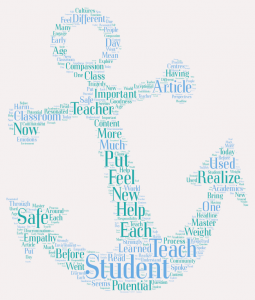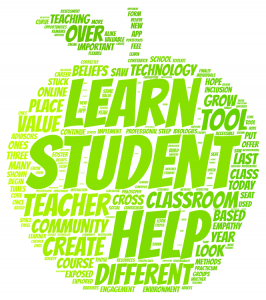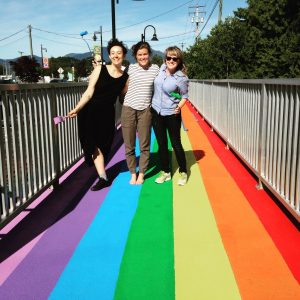It is now time to take a look back on the past twelve months of my BEd. So here we go!
- Where have I come from?
Looking back on where I was last September is harder than I thought it would be. It seems like it was years ago, rather than just over 11 months. The only valuable experience that I had in classrooms was when I was a student myself. My volunteer experience prior to the program took place outside of the classroom.
Growing up, I always loved school. I loved reading, writing, and just learn ing in general. However, looking back now, I did not just love learning, but doing well. I was that student that liked seeing straight A’s on my report cards; grades were very important to me. Even when I was in elementary school I remember always wanting to get a perfect score on my spelling or math tests. I thought that the majority of teaching involved a rigorous academic approach. Looking back at my favourite teachers, there was a common thread
ing in general. However, looking back now, I did not just love learning, but doing well. I was that student that liked seeing straight A’s on my report cards; grades were very important to me. Even when I was in elementary school I remember always wanting to get a perfect score on my spelling or math tests. I thought that the majority of teaching involved a rigorous academic approach. Looking back at my favourite teachers, there was a common thread
that links them together. These teachers made school fun and engaging, but I remember learning a lot. That is why I chose teaching as my profession, because of those memorable teachers who made school an enjoyable, but challenging, place to be. They created environments where it was easy to enjoy learning and provided support to succeed.
2. What are my educational commitments?
Like I said before, I used to put almost all of the weight on academics. I now realize that there is so much more to teaching than having students master content. In our Classroom Community class one article we read strongly resonated with me. The article spoke about each student’s “potential goodness” and the process a teacher went through to help a student realize their potential. Today it seems as if every other day there is a new tragedy on the news where the headline also centres around discrimination. I feel it is so important to bring different perspectives into the classroom to help students understand at an early age that the world has so many different, exceptional people and cultures in it. Compassion and empathy are learned emotions and teachers have a responsibility (or commitment) to teach them.
new tragedy on the news where the headline also centres around discrimination. I feel it is so important to bring different perspectives into the classroom to help students understand at an early age that the world has so many different, exceptional people and cultures in it. Compassion and empathy are learned emotions and teachers have a responsibility (or commitment) to teach them.
As important as it is to teach compassion and empathy, it is also important to do so in an environment where students feel safe and respected, not just by the teacher but by each other. I do not just mean safe from harm, but safe to question, explore, and engage with their learning.
3.How will I practice?
Over the last year we have been exposed to many different values, beliefs, and methods in our courses and from our different school advisors. There are three ideologies that have stuck with me and are ones that I hope to continue grow with as a professional and implement in my classroom.
From my teaching philosophy…
Over the course of my practicum I saw how valuable Place-based learning is. My students were shown what their environment has to offer them as individuals and as a community. We also explored how it was important to groups in other times. Place-based learning creates cross-curricular opportunities and can also put the teacher in the ‘learner’s seat’.
As I begin my career, I am constantly looking for tools and resources to help foster student learning and engagement and technology can help. When accessible and used correctly, technology can help with assessment, communication, and engagement. Incorporating new technologies in the classroom, whether it be in the form of an app, online presentation tool, or online portfolios, can have a steep lea rning curve for teachers and students alike. Once those barriers are crossed, teachers can have more tools in their ‘toolkit’ to help differentiate instruction and create a flexible space for student learning.
rning curve for teachers and students alike. Once those barriers are crossed, teachers can have more tools in their ‘toolkit’ to help differentiate instruction and create a flexible space for student learning.
Finally, I believe that teachers have a social responsibility to help students learn empathy. This could look different class to class, but the core value remains the same. Teaching students about different perspectives and beliefs will help build respectful and generous communities. I feel this is extremely important in today’s society because children can be overexposed to media, violence, and aggression. Creating an environment of inclusion and empathy in a classroom will help students grow into inclusive and empathetic adults.
4. How will I continue to grow professionally?
This last year I had the privilege to be a part of a group of exceptionally kind, passionate, and generous people. I consider the new friends that I have made in this profession the greatest resource I have. When we were planning for practicum, the casual conversations, shared projects, and overall support showed how much we can learn from one another. We all come into this profession with different strengths and weaknesses and there was such a willingness to encourage one another. I am so proud of my new friends and all they have accomplished and I look forward to sharing ideas and finding our places in the education community.
I was able to attend STA Convention in Surrey because of my practicum placement. I was so surprised at the variety of wor kshops that were offered for teaches. There was everything from “Yoga in your Classroom” to “How to cope with bullying in your classroom”. It was a tremendous opportunity for me and my fellow TCs. I believe teachers have a responsibility to capitalize on opportunities given to them to ensure that a Pro-D day is meaningful.
kshops that were offered for teaches. There was everything from “Yoga in your Classroom” to “How to cope with bullying in your classroom”. It was a tremendous opportunity for me and my fellow TCs. I believe teachers have a responsibility to capitalize on opportunities given to them to ensure that a Pro-D day is meaningful.
Lastly, I plan to grow professionally by taking risks. It is important to try new things and push oneself in order to continue to learn and grow. Taking risks creates opportunities for meaningful learning for one’s students. I tried to challenge myself during practicum by trying out risky ideas/lessons that I thought had potential and by implementing new technologies; some were successful, some were not, and others were learning opportunities that allowed me to reflect on what I would change and adapt for the next lesson.
Well that is all for this chapter! Now let’s see what September brings!
 themselves with respect to both problem solving and their fine and gross motor skills. Perhaps what was the most interesting is the different types of support needed within the room. Some students needed to imagine that the room was a “Minecraft” obstacle course in order to engage with the room, others dived right in without any prompting. The Sensory Room is an adapted learning environment for students who need it, but is then further adapted to the needs of individuals as well.
themselves with respect to both problem solving and their fine and gross motor skills. Perhaps what was the most interesting is the different types of support needed within the room. Some students needed to imagine that the room was a “Minecraft” obstacle course in order to engage with the room, others dived right in without any prompting. The Sensory Room is an adapted learning environment for students who need it, but is then further adapted to the needs of individuals as well.





